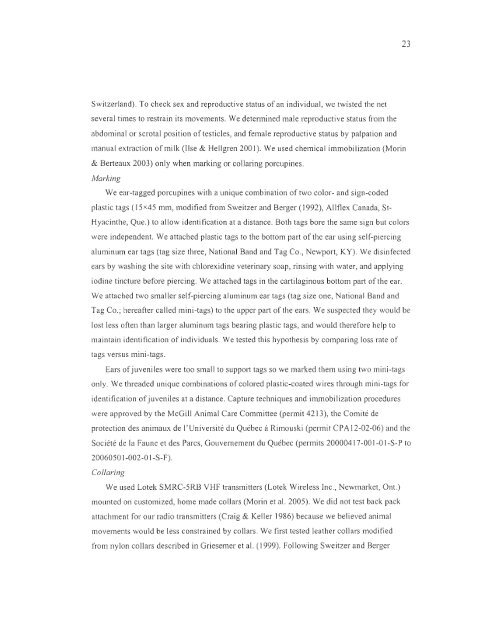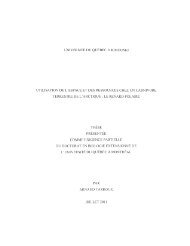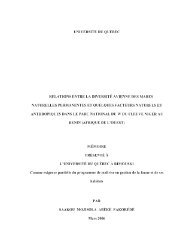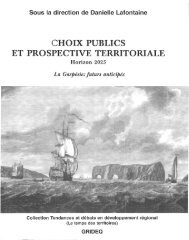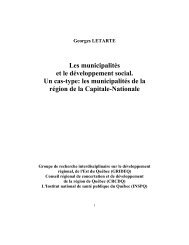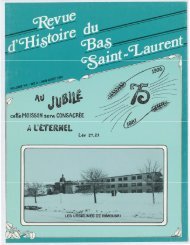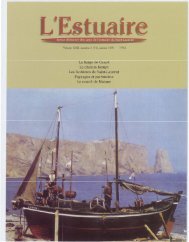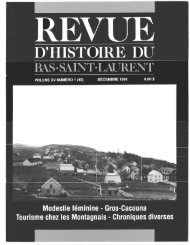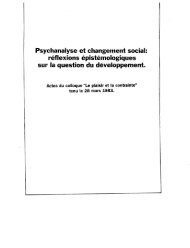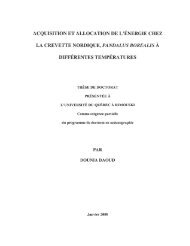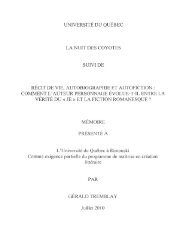influence du climat et de la prédation sur l'utilisation de l'habitat et la ...
influence du climat et de la prédation sur l'utilisation de l'habitat et la ...
influence du climat et de la prédation sur l'utilisation de l'habitat et la ...
Create successful ePaper yourself
Turn your PDF publications into a flip-book with our unique Google optimized e-Paper software.
23<br />
Switzer<strong>la</strong>nd). To check sex and repro<strong>du</strong>ctive status of an indivi<strong>du</strong>al, we twisted the n<strong>et</strong><br />
several times to restrain its movements. We d<strong>et</strong><strong>et</strong>mined male repro<strong>du</strong>ctive status from the<br />
abdominal or sc rotai position of testicles, and female repro<strong>du</strong>ctive status by palpation and<br />
manual extraction ofmilk (Ilse & Hellgren 2001). We used chemical immobilization (Morin<br />
& Berteaux 2003) only when marking or col<strong>la</strong>ring porcupines.<br />
Marking<br />
We ear-tagged porcupines with a unique combination oftwo color- and sign-co<strong>de</strong>d<br />
p<strong>la</strong>stic tags (15 x45 mm, modified from Sweitzer and Berger (1992), Alltlex Canada, St-<br />
Hyacinthe, Que.) to allow i<strong>de</strong>ntification at a distance. Both tags bore the same sign but colors<br />
were in<strong>de</strong>pen<strong>de</strong>nt. We attached p<strong>la</strong>stic tags to the bottom part of the ear using self-piercing<br />
aluminum ear tags (tag size three, National Band and Tag Co., Newport, KY). We disinfected<br />
ears by washing the site with chlorexidine v<strong>et</strong>erinary soap, rinsing with water, and applying<br />
iodine tincture before piercing. We attached tags in the carti<strong>la</strong>ginous bottom part of the ear.<br />
We attached two smaller self-piercing aluminum ear tags (tag size one, National Band and<br />
Tag Co.; hereafter ca lied mini-tags) to the upper part of the ears. We suspected they wou Id be<br />
lost less often than <strong>la</strong>rger aluminum tags bearing p<strong>la</strong>stic tags, and would therefore help to<br />
maintain i<strong>de</strong>ntification of indivi<strong>du</strong>als. We tested this hypothesis by comparing loss rate of<br />
tags versus mini-tags.<br />
Ears of juveniles were too small to support tags so we marked them using two mini-tags<br />
only. We threa<strong>de</strong>d unique combinations of colored p<strong>la</strong>stic-coated wires through mini-tags for<br />
i<strong>de</strong>ntification of juveniles at a distance. Capture techniques and immobilization proce<strong>du</strong>res<br />
were approved by the McGill Animal Care Committee (permit 4213), the Comité <strong>de</strong><br />
protection <strong>de</strong>s animaux <strong>de</strong> l'Université <strong>du</strong> Québec à Rimouski (permit CPAI2-02-06) and the<br />
Société <strong>de</strong> <strong>la</strong> Faune <strong>et</strong> <strong>de</strong>s Parcs, Gouvernement <strong>du</strong> Québec (permits 20000417-001-0 I-S-P to<br />
20060501-002-01-S-F).<br />
Co /<strong>la</strong>ring<br />
We used Lotek SMRC-5RB VHF transmitters (Lotek Wireless Inc., Newmark<strong>et</strong>, Ont.)<br />
mounted on customized, home ma<strong>de</strong> col<strong>la</strong>rs (Morin <strong>et</strong> al. 2005). We did not test back pack<br />
attachment for our radio transmitters (Craig & Keller 1986) because we believed animal<br />
movements would be less constrained by col<strong>la</strong>rs. We first tested leather col<strong>la</strong>rs modified<br />
from nylon coll ars <strong>de</strong>scribed in Griesemer <strong>et</strong> al. (1999). Following Sweitzer and Berger


